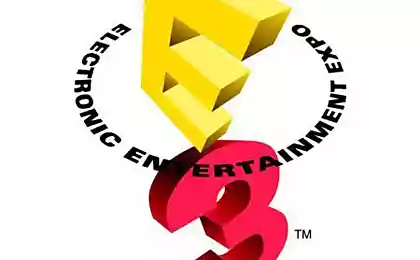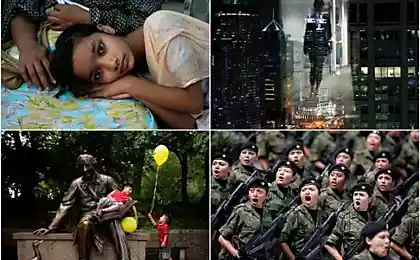785
What bothered humanity in the past 2011.

Memorable ekofakty 2011, that will help us remember that the care of humanity in the past year.
- Every 20 minutes, from the face of the earth disappears one species of animal.
- Every year in the world in the production of hydrocarbons burned waste 400 million tons of natural gas. This amount of gas will be enough for 77 million cars a year.
- On heating per inhabitant per year is spent in Moscow 4 tons of fuel equivalent.
- A total dump in Russia occupy an area of more than 2 million square kilometers. Each year, the amount of waste increased by 7 billion tonnes, while for recycling takes no more than one third of the incoming volume.
- Since the beginning of the Industrial Revolution about 500 billion tons of carbon dioxide was absorbed by the waters of the oceans. As a result, over the past century, the acidity of the waters of the oceans has increased by 30%.
- According to the latest projections of the Population Division of the United Nations world population by 2100 may reach 10, 1 billion people. Great contribution to the growth of the population of the planet will make Africa. The population of this continent will increase from 1 billion to 3, 6.
- Some 80,000 different chemicals present in food and consumer goods.
- According to rough estimates 15-20% of global carbon emissions falls on tropical deforestation.
- At the beginning of the 2000s in the tropical forests of 75 countries it contains about 247 billion tonnes of carbon. As a result of fossil fuel burning and land use changes in the atmosphere of our planet each year is 10 billion tons of carbon.
- Researchers have found that 49% of the deposited carbon has to tropical forests in Latin America. In the forests of Brazil account for 61 billion tons of carbon sequestered. In comparison, slightly more than the deposited carbon (62 billion tons) are in the forest all the African countries south of the Sahara.
- The total capacity of solar power plants to be built and launched in Russia in 2020 will amount to 150 MW.
- Over the last 2,100 years the maximum increase in the sea level is noted at the end of the 19th century.
- Studies of some scientists suggest that the urban population, in contrast to the rural, the risk of mental disorders by 21% higher, and the deterioration in sentiment in the 39%. Moreover, the risk of schizophrenia among those born and raised in the village, and then moved to the city in 2 times higher than in humans, all of which took place in his childhood town.
- 1 m2 of urban vegetation of the temperate zone can bind (deposit) of about 3, 16 kg of carbon.
- Today, the focus of the world community drawn to the climate change problem in the first place - to anthropogenic emissions (CO2). However, a key regulator of the Earth's climate is wildlife (Bukvarёva, 2010). Anthropogenic emissions make up only a small percentage (3, 4% according to the IPCC, 2007) of the total flow of carbon in the biosphere. For example, the microbial decomposition of organic matter in the soil - the main return path of carbon from terrestrial ecosystems to the atmosphere - more than 7 times its industrial emissions (Zavarzin, Kudeyarov, 2006). Carbon stocks in biomass and soil, the top layer of permafrost peat and thousands of times more powerful than man-made stream.
- In China, the beginning of the 1990s, annual damage from mass deforestation accounted for 12% of GDP, while its main part (92%) was the result of degradation of the environment-forming functions of the forest (Ya-Shi et al., 1997), which led to catastrophic wind and water erosion, dust storms, desertification, ocean pollution river soil and soil offsets.
- The annual investment of $ 45 billion to maintain ecosystem services allows to $ 5 trillion in protected areas (to save the ecosystem services of the planet requires 6 times more expensive).
- An example of the interest in supporting the conservation of forest ecosystems by the local population due to benefit from NTFP can serve Tomsk region. Currently, outside of the area is taken out of mushrooms, berries, pine nuts, medicinal plants and their products worth about 1 billion. Rub. The share of non-timber forest products is around 1% of the value of natural capital and the Tomsk region 20 times the actual economic value of forest resources.
- Biodiversity of our planet is roughly estimated 14000000 species are known to science (discussed) Only 1750000.
Forests cover 4 billion hectares (31% of the total surface of the planet). Five "forest countries" (Russia, Canada, Brazil, the US and China) account for more than half of the world's forests.
- Implicit loss of forest ecosystems of the Earth, is now about 28 billion. Euros annually, which is comparable to the losses from the last global crisis.
The share of the ecosystem services of global GDP is 6.8%, while global GDP for the poor 40-50%.
- The loss of natural capital in the deforestation and degradation of forests and is 2-4, 5 trillion. dollars. US per year. By investing 45 billion. Dollars. Per year in protected areas can obtain ecosystem services worth 5 trillion. per year.
- About 40% of world trade is related to products or processes related to biodiversity, such as agriculture, forestry, fishing and plant-derived pharmaceutical products. Biodiversity is an invaluable source for innovation.
90% of our time is spent indoors. On life support buildings consumes 40% of all energy produced in the world. In Europe, 30% of all buildings do not provide a healthy indoor climate.
- From 1990 to 1999. the number of buildings that have received deformation due to uneven subsidence of frozen soil base increased by 42% in Norilsk, 61% in Yakutsk, and 90% in Amderma (NAO). In the United States (Alaska) to improve the reliability of pipelines in permafrost using the latest technology ("floating foundation"). Price appreciation Alaska oil pipeline length of 1, 5 thous. Km. It is 5 million. tons (1/2000 has been spent on the system of oil reserves, which provides protection against negative processes associated with permafrost thawing) (M. Schatz).
As a result of the melting of very icy rocks Yakutia annually loses 11 square meters. km. sushi. In the next 25-30 years, the average annual temperature on the Arctic coast of Siberia could increase N 3-5 ° C in Yakutia; the Far East and the north of European Russia at 2-4 ° C. It is in the next 25-30 years will lead to a reduction in the area of mnogoletnemerzlotnyh rocks (MMP) by 10-18%, and some of them will go to the relict condition or completely protal. Moreover, by mid-century the territory of the IMF is reduced by 15-30%, while its boundary will shift to the northeast of 150-200 km (M. Schatz).
After 1966 in Yakutsk, the coldest November-March warmed to 3-6 ° C, average winter temperatures, with an average for 1961-1990. - 25, 9 ° C, increased by almost 4 ° C, while the average annual temperature by nearly 3 ° C (M. Schatz).
- Judging by the forecasts (Corresponding Member of the Russian Academy of Sciences IMZ VT Balobaev and prof. VV Shepelev from IMZ) warming over 2010-2015. And then comes a cold snap, which runs until 2060.
- Increased man-made pressures on the environment, especially the combination of radiation-toxic, are "risk factors" of brain dysfunction in children of preschool age. The highest percentage of preschool children with impaired physical development of harmony revealed in kindergartens in urban areas with high levels of pesticide and combined radiation-induced environmental loads (YM Sadovnikov, GP Zolotnikova).
- The functional state of teens residing in cities with high levels of toxic-chemical contamination, characterizing high blood pressure (systolic and diastolic), decrease in the average duration of the PR-interval and a decrease in the rate of sensorimotor responses to visual stimulus (RV Kurguz, G. P. Zolotnikova).
- An average of 1 hectare of greenery for one hour consumes 8 kg of carbon dioxide, i.e. the same amount, which in the same period 200 people exhale. Greenery significantly reduce the concentration of pollutants such as sulfur dioxide (0, 08 to 0, 27 mg / 3), hydrogen sulfide (from 0 007 to 0 026 mg / m3). Groups of trees retain 21-86% of dust and 19-44% decrease air pollution by microorganisms. In general, it is estimated that the vegetation absorbs from the air and binds 50-60% of toxic gases, while 5-20% of atmospheric moisture, soil - 5.10%, ponds - less than 5% (Frolov AA 1998) < br />
- Deep green area at a distance of 250 m from its border dust content in the air is reduced by more than 2, 5 times. Pylezaderzhivayuschie properties of different species of trees and shrubs are not the same. It is best to retain the dust and rough foliage elm leaf lilac-coated fibers. Elm Leaves detain dust is about 5 times larger than the leaves of poplar; lilac leaves 3 times more poplar, etc. (IO Sharygina)
- According to specifications per inhabitant metropolis must have to 10m2 area of greenery.
- Sulfur dioxide - the main pollutant in urban air basin reduces the intensity of photosynthesis pine on 75-83% from 48-85% in the spruce, larch at 19-51%, linden - at 15-36% (IO . Sharygina).
- Oak forest annual increment of branches is typically 180-200 mm in a suburban park - 65-70 mm, the park industrial district - 20-30 mm. Linden branches in the forest gains observed 150-180 mm in the park of a residential area - 45-60 mm, and in street plantings - 15-16 mm (Frolov AA, 1998).
If in vivo tillet live to 500 years or more, in urban areas it is considered to be an age limit on the boulevards - 90 years, street plantings - 65-70 years (Kovyazin VF, 2006).
- According to the Territorial Production Association of landscape management and green building of St. Petersburg in 2009, 35% of green areas accounted for much weakened and weakened trees (IO Sharygina).
- Man-made low-frequency magnetic noise in large cities exceeds the variation of the unperturbed geomagnetic field hundreds of times. The population of the large industrial centers and their surroundings is constantly under the influence of the electromagnetic field is strongly perturbed low and very low frequencies, which is similar to the natural magnetic storm intensity of 4-6 points (DS Tjagunov).
- In Russia annually produces about 40 million tons of municipal solid waste (MSW), of which only 35% recyclable. This is currently utilized only 10% of waste (Waste Recycling in the EU, 2010). In some EU countries per capita of 400-700 kg of solid waste, are recycled or composted 60-70% (Market waste, 2010).
- The composition of solid waste includes: paper - 40%, the dregs of food - 20%, glass, plastic, wood, rubber, textiles and more.
- The amount of waste in the territory of the Southern Federal District is increasing annually by an average of 10 - 15 percent (VS Demyanova, SV Dyrova).
- In Russia, at the end of 2009, it was placed 15 th. For the landfill and 10 thousand. Unauthorized.
- According to German researchers each spectator sporting event after the leaves about 200 garbage. So, after a major sporting event produces about 3,000 tons of waste.
- We know that 3/4 of all species of flowering plants, mammals, 1/4, 1/2 of all insects and reptiles are threatened with extinction. Unless security measures are taken, by 2100 half of the known species will disappear from the face of the Earth.
- In the southern Baikal region for the past 20 years the average annual temperature has increased from 0, 6 to 0, 6 ° C.
- Recovery of indigenous forests usually takes variously estimated time period of at least 200-300 years, taking into account the whole complex of the factors and conditions in the northern and middle taiga to restore indigenous forests must be 500-600 years (Danilov-VI, Losev KS, Volkov AD, Gromtseva AN)
- The soils of the northern regions of the Earth contains about 1, 7 billion tons of carbon dioxide. About 88% of this amount of carbon dioxide locked in the permafrost.























